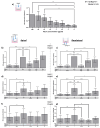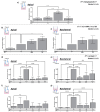The Pestivirus RNase Erns Tames the Interferon Response of the Respiratory Epithelium
- PMID: 39772215
- PMCID: PMC11680131
- DOI: 10.3390/v16121908
The Pestivirus RNase Erns Tames the Interferon Response of the Respiratory Epithelium
Abstract
Bovine viral diarrhea virus (BVDV), a pestivirus in the family Flaviviridae, is a major livestock pathogen. Horizontal transmission leads to acute transient infections via the oronasal route, whereas vertical transmission might lead to the birth of immunotolerant, persistently infected animals. In both cases, BVDV exerts an immunosuppressive effect, predisposing infected animals to secondary infections. Erns, an immunomodulatory viral protein, is present on the envelope of the virus and is released as a soluble protein. In this form, it is taken up by cells and, with its RNase activity, degrades single- and double-stranded (ds) RNA, thus preventing activation of the host's interferon system. Here, we show that Erns of the pestiviruses BVDV and Bungowannah virus effectively inhibit dsRNA-induced IFN synthesis in well-differentiated airway epithelial cells cultured at the air-liquid interface. This activity was observed independently of the side of entry, apical or basolateral, of the pseudostratified, polarized cell layer. Virus infection was successful from both surfaces but was inefficient, requiring several days of incubation. Virus release was almost exclusively restricted to the apical side. This confirms that primary, well-differentiated respiratory epithelial cells cultured at the air-liquid interface are an appropriate model to study viral infection and innate immunotolerance in the bovine respiratory tract. Furthermore, evidence is presented that Erns might contribute to the immunosuppressive effect observed after BVDV infections, especially in persistently infected animals.
Keywords: IFN antagonist; air–liquid interface (ALI); bovine viral diarrhea virus (BVDV); glycosaminoglycan (GAG)-binding site; innate immune evasion; interferon type-I; pestivirus; respiratory epithelium; viral RNase; viral endonuclease.
Conflict of interest statement
The authors declare no conflicts of interest.
Figures






Similar articles
-
Prolonged activity of the pestiviral RNase Erns as an interferon antagonist after uptake by clathrin-mediated endocytosis.J Virol. 2014 Jul;88(13):7235-43. doi: 10.1128/JVI.00672-14. Epub 2014 Apr 16. J Virol. 2014. PMID: 24741078 Free PMC article.
-
Fifty Shades of Erns: Innate Immune Evasion by the Viral Endonucleases of All Pestivirus Species.Viruses. 2022 Jan 27;14(2):265. doi: 10.3390/v14020265. Viruses. 2022. PMID: 35215858 Free PMC article.
-
The viral RNase E(rns) prevents IFN type-I triggering by pestiviral single- and double-stranded RNAs.Virus Res. 2009 Mar;140(1-2):15-23. doi: 10.1016/j.virusres.2008.10.015. Epub 2008 Dec 16. Virus Res. 2009. PMID: 19041350
-
What can pestiviral endonucleases teach us about innate immunotolerance?Cytokine Growth Factor Rev. 2016 Jun;29:53-62. doi: 10.1016/j.cytogfr.2016.03.003. Epub 2016 Mar 17. Cytokine Growth Factor Rev. 2016. PMID: 27021825 Free PMC article. Review.
-
BVDV and innate immunity.Biologicals. 2003 Jun;31(2):107-12. doi: 10.1016/s1045-1056(03)00024-1. Biologicals. 2003. PMID: 12770540 Review.
References
-
- Postler T.S., Beer M., Blitvich B.J., Bukh J., de Lamballerie X., Drexler J.F., Imrie A., Kapoor A., Karganova G.G., Lemey P., et al. Renaming of the genus Flavivirus to Orthoflavivirus and extension of binomial species names within the family Flaviviridae. Arch. Virol. 2023;168:224. doi: 10.1007/s00705-023-05835-1. - DOI - PubMed
-
- Olafson P., MacCallum A.D., Fox F.H. An apparently new transmissible disease of cattle. Cornell Vet. 1946;36:205–213. - PubMed
-
- Evermann J.F., Barrington G.M. Clinical features. In: Goyal S.M., Ridpath J.F., editors. Bovine Viral Diarrhea Virus: Diagnosis, Management, and Control. Blackwell Publishing; Ames, IA, USA: 2005. pp. 105–119.
Publication types
MeSH terms
Substances
Grants and funding
LinkOut - more resources
Full Text Sources

